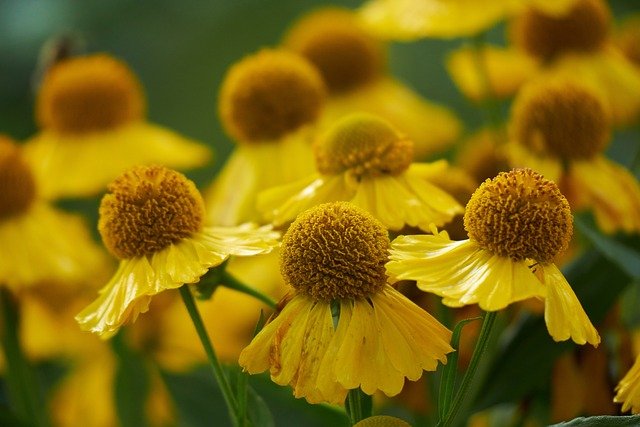Swamp Sunflower
(Helienium autumnale)
Sneezeweed’s unusually shaped yellow petals rise from equally strange, winged stems. It grows up to 4 feet tall and can be cut back in early summer (late June or early July) to force shorter, more-branched flowering heads. It prefers moist to wet soil but is adaptable to average, full-sun sites. It is a larval host for the Dainty Sulphur butterfly.
According to a 1923 publication by H. Smith of the Milwaukee Public Museum, the name given to the plant by the Menominee Indians of the Wisconsin area is "aiatci'a ni'tcîkûn," which means "sneezing spasmodically". With its large showy flowers, insects pollinate common sneezeweed, not wind. Therefore, it does not have small pollen grains, like ragweed does, which cause sneezing and other hay fever symptoms. The common name is based on historic use of the crushed dried leaves and heads to make a form of snuff that caused sneezing. In certain cultures and times, sneezing was regarded as a desirable way to rid the body of evil spirits or a way to loosen up a head cold, so that a sneeze-producing remedy was desirable.
(Helienium autumnale)
Sneezeweed’s unusually shaped yellow petals rise from equally strange, winged stems. It grows up to 4 feet tall and can be cut back in early summer (late June or early July) to force shorter, more-branched flowering heads. It prefers moist to wet soil but is adaptable to average, full-sun sites. It is a larval host for the Dainty Sulphur butterfly.
According to a 1923 publication by H. Smith of the Milwaukee Public Museum, the name given to the plant by the Menominee Indians of the Wisconsin area is "aiatci'a ni'tcîkûn," which means "sneezing spasmodically". With its large showy flowers, insects pollinate common sneezeweed, not wind. Therefore, it does not have small pollen grains, like ragweed does, which cause sneezing and other hay fever symptoms. The common name is based on historic use of the crushed dried leaves and heads to make a form of snuff that caused sneezing. In certain cultures and times, sneezing was regarded as a desirable way to rid the body of evil spirits or a way to loosen up a head cold, so that a sneeze-producing remedy was desirable.
(Helienium autumnale)
Sneezeweed’s unusually shaped yellow petals rise from equally strange, winged stems. It grows up to 4 feet tall and can be cut back in early summer (late June or early July) to force shorter, more-branched flowering heads. It prefers moist to wet soil but is adaptable to average, full-sun sites. It is a larval host for the Dainty Sulphur butterfly.
According to a 1923 publication by H. Smith of the Milwaukee Public Museum, the name given to the plant by the Menominee Indians of the Wisconsin area is "aiatci'a ni'tcîkûn," which means "sneezing spasmodically". With its large showy flowers, insects pollinate common sneezeweed, not wind. Therefore, it does not have small pollen grains, like ragweed does, which cause sneezing and other hay fever symptoms. The common name is based on historic use of the crushed dried leaves and heads to make a form of snuff that caused sneezing. In certain cultures and times, sneezing was regarded as a desirable way to rid the body of evil spirits or a way to loosen up a head cold, so that a sneeze-producing remedy was desirable.

